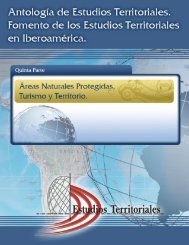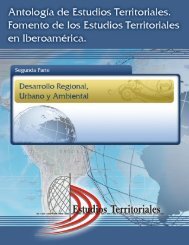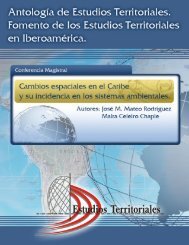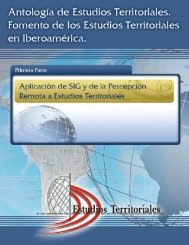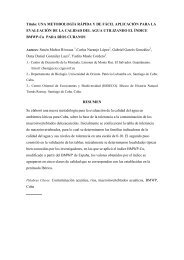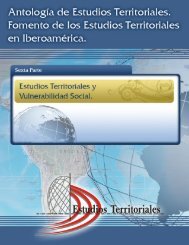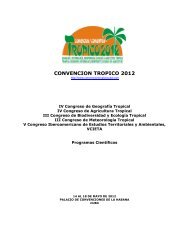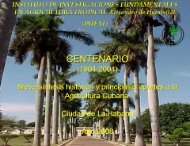- Page 2 and 3: II CONGRESO DE BIODIVERSIDAD Y ECOL
- Page 4 and 5: PROGRAMA CIENTÍFICO CONVENCION TRO
- Page 6 and 7: RESÚMENES
- Page 8 and 9: BR 02 EL SOLAR MAYA Y SU INTERACCIO
- Page 10 and 11: BR04 EVALUACIÓN DE LA ACTIVIDAD AN
- Page 12 and 13: BR06 VALORACIÓN DE LAS CATEGORÍAS
- Page 14 and 15: BR08 BIODIVERSIDAD AMENAZADA EN LAS
- Page 16 and 17: BR10 DIVERSIDAD ICTIOLÓGICA Y ASPE
- Page 18 and 19: BR12 INVENTARIO Y DISTRIBUCIÓN GEO
- Page 20 and 21: BR14 TIPOS FUNCIONALES DE ÁRBOLES
- Page 22 and 23: BR16 PATRONES Y ACUMULACIÓN DE CAR
- Page 24 and 25: BR18 LA IMPORTANCIA DE LOS ÁRBOLES
- Page 28 and 29: BR22 EVOLUCION ESPACIO-TEMPORAL DE
- Page 30 and 31: BR24 CURITIBA, LA CAPITAL ECOLÓGIC
- Page 32 and 33: BR26 ESQUEMAS CONCEPTUALES Y METODO
- Page 34 and 35: BR28 CARACTERIZACIÓN DE LA FAUNA E
- Page 36 and 37: BR30 ESPECIES EXÓTICAS EN EL MAR C
- Page 38 and 39: de látex y las productoras de acei
- Page 40 and 41: BR33 INVENTARIO PRELIMINAR DE LA AR
- Page 42 and 43: BR35 EVALUACIÓN DE LA DISPONIBILID
- Page 44 and 45: BR37 RIQUEZA DE ESPECIES Y ENDEMISM
- Page 46 and 47: BR39 POBLACIONES ENDOSIMBIONTES ASO
- Page 48 and 49: BR41 CARACTERIZACIÓN DEL POTENCIAL
- Page 50 and 51: BR43 NUEVAS ADICIONES AL MACROFITOB
- Page 52 and 53: BR45 FLORA DE LA SABANA SOBRE MOCAR
- Page 54 and 55: BR47 DISTRIBUCIÓN VERTICAL DE LA B
- Page 56 and 57: BR49 ACTUALIZACIÓN DE LA INFORMACI
- Page 58 and 59: BR51 ASPECTOS ECOLÓGICOS DE SEIS E
- Page 60 and 61: BR53 MANEJO Y EVOLUCIÓN DE LA COLE
- Page 62 and 63: BR55 COLECTA Y RESCATE DEL CONOCIMI
- Page 64 and 65: BR57 Capsicum annum L. EN MÉXICO.
- Page 66 and 67: BR59 RECURSOS FORESTALES NO MADERAB
- Page 68 and 69: BR61 INDUCCIÓN A MORFOGÉNESIS IN
- Page 70 and 71: BR63 EL JARDIN BOTANICO DE LA UNIVE
- Page 72 and 73: BR65 CONSERVACIÓN EX SITU DE LA DI
- Page 74 and 75: BR67 IMPACTOS DE LA ACTIVIDAD ANTR
- Page 76 and 77:
BR69 LA FLORA EN SUS ALTERNATIVAS Y
- Page 78 and 79:
BR71 LA MACROFAUNA DE INVERTEBRADOS
- Page 80 and 81:
BR73 TENDENCIAS DE REGENERACIÓN NA
- Page 82 and 83:
BR75 FRAGMENTACIÓN DE HUMEDALES CO
- Page 84 and 85:
BR77 ESTUDIO DE LA REGENERACIÓN DE
- Page 86 and 87:
BR79 FRAGMENTACIÓN DE LA VEGETACI
- Page 88 and 89:
BR81 LA FLORA Y LA VEGETACIÓN ASOC
- Page 90 and 91:
BR83 INVENTARIO CINEGÉTICO EN SECT
- Page 92 and 93:
Estado actual y perspectivas del Si
- Page 94 and 95:
No es precisamente la falta de dato
- Page 96 and 97:
A partir de 1959, y más recienteme
- Page 98 and 99:
generada hasta el momento, para lo
- Page 100 and 101:
tecnológico y metodológico de la
- Page 102 and 103:
De forma más particular, la Agenci
- Page 104 and 105:
Biodiversidad amenazada en las Áre
- Page 106 and 107:
Nacional de Cuba (1989). La identif
- Page 108 and 109:
Los invertebrados están representa
- Page 110 and 111:
ecosistemas, los recursos florísti
- Page 112 and 113:
PERÍODO REPRODUTIVO E FORMAÇÃO D
- Page 114 and 115:
lançamento de botões e a antese d
- Page 116 and 117:
Eventos Meses Espata fechada Botõe
- Page 118 and 119:
3.2. Formação e amadurecimento do
- Page 120 and 121:
3.3. Produção de frutos Foi encon
- Page 122 and 123:
predação, patogenia ou partenocar
- Page 124 and 125:
Granville, J.J. 1992. Life forms an
- Page 126 and 127:
la realidad, de ahí sus limitacion
- Page 128 and 129:
familias de cada distrito, y la riq
- Page 130 and 131:
El ACP se completa con una matriz d
- Page 132 and 133:
distritos tienen todos más de 280
- Page 134 and 135:
(Tabla 4). El mayor intervalo entre
- Page 136 and 137:
distritos con ambos signos. Por esa
- Page 138 and 139:
1) La estructura de la diversidad d
- Page 140 and 141:
REFERENCIAS Acevedo, M. (1989): Reg
- Page 142 and 143:
Whittaker, R. H. (1973): Direct gra
- Page 144 and 145:
plantas (TFP`s), los cuales permite
- Page 146 and 147:
Materiales y métodos Área de estu
- Page 148 and 149:
Contenido foliar de materia seca La
- Page 150 and 151:
2 Árboles 3 Palmas 4 Árboles 1 Á
- Page 152 and 153:
TFP2 TFP3 TFP4 TFP5 TFP1 Conceveiba
- Page 154 and 155:
Cuadro 7. MANOVA (Lawley-Hotelling)
- Page 156 and 157:
Conclusiones Los siete rasgos folia
- Page 158 and 159:
N; Mowforth, MA; Neal, RJ; Reader,
- Page 160 and 161:
Apéndice 1. Especies que ocupan el
- Page 162 and 163:
Apéndice 1. Continuación FAMILIA
- Page 164 and 165:
2- Comparar la acumulación de carb
- Page 166 and 167:
prueba de Monte Carlo, indicó que
- Page 168 and 169:
En el censo de las especies de los
- Page 170 and 171:
Conclusiones: 1-Los valles donde oc
- Page 172 and 173:
Figuras. Fig 1. Sitios de Estudios
- Page 174 and 175:
Fig 3. Ordenación del análisis de
- Page 176 and 177:
Fig 4. Logaritmo del contenido de c
- Page 178 and 179:
1 ABSTRACT This work was developed
- Page 180 and 181:
3 MATERIALES Y METODOS: Este trabaj
- Page 182 and 183:
5 Tabla 1: Lista taxonómica de las
- Page 184 and 185:
7 humanas son completamente dependi
- Page 186 and 187:
9 Relación planta-animal. Tabla 3.
- Page 188 and 189:
11 BIBLIOGRAFIA. 1. Begué-Quiala G
- Page 190 and 191:
REFORESTACIÓN SUCESIÓNAL EN ÁREA
- Page 192 and 193:
ióticas del bosque, y sobre estos
- Page 194 and 195:
Tabla 1. Ponderación de los valore
- Page 196 and 197:
condiciones de forma estable. Es es
- Page 198 and 199:
50 Porcentajes 40 30 20 10 0 I II I
- Page 200 and 201:
SE que generalmente son relativamen
- Page 202 and 203:
vegetal bosque siempreverde notófi
- Page 204 and 205:
Anexo 1. Listado florístico de esp
- Page 206 and 207:
Esquemas conceptuales y metodológi
- Page 208 and 209:
principios, el ordenamiento ecológ
- Page 210 and 211:
casos, se promueven usos del suelo
- Page 212 and 213:
Materiales y Métodos Se llevó a c
- Page 214 and 215:
Los grupos de aptitud formados por
- Page 216 and 217:
utilizados. Además, el papel de lo
- Page 218 and 219:
Cendrero, A., J.R. Díaz De Terán,
- Page 220 and 221:
Saaty, T. 1980. The analytical hier
- Page 222 and 223:
Introducción En la actualidad el m
- Page 224 and 225:
2500 posturas por parcelas, cifra e
- Page 226 and 227:
Antes de realizar los pregerminador
- Page 228 and 229:
Conclusiones - Con la utilización
- Page 230 and 231:
1 Diversidad y composición de Macr
- Page 232 and 233:
3 Materiales y métodos Diseño exp
- Page 234 and 235:
5 et al. 1997; Devries et al. 1997)
- Page 236 and 237:
7 Se encontró un efecto del estado
- Page 238 and 239:
9 ARMENTERAS, D.; GAST, F.; VILLARE
- Page 240 and 241:
11 YELA, J.L.; HERRERA, C.M. 1993.
- Page 242 and 243:
13 Figura 1. Riqueza de Heterocera
- Page 244 and 245:
(Neyra et al., 2006; Rodríguez et
- Page 246 and 247:
para todas las variables cuantitati
- Page 248 and 249:
según los cuales la abundancia de
- Page 250 and 251:
ESPECIES (%) INDIVIDUOS (%) OJO DE
- Page 252 and 253:
cavidades estaba ocupada por una pa
- Page 254 and 255:
efecto negativo causado por el hura
- Page 256 and 257:
cavadoras de cavidades, que parece
- Page 258 and 259:
CONVENCIÓN TRÓPICO CUBA 2008 FAUN
- Page 260 and 261:
CONVENCIÓN TRÓPICO CUBA 2008 de l
- Page 262 and 263:
CONVENCIÓN TRÓPICO CUBA 2008 Aves
- Page 264 and 265:
CONVENCIÓN TRÓPICO CUBA 2008 Tabl
- Page 266 and 267:
CONVENCIÓN TRÓPICO CUBA 2008 Colu
- Page 268 and 269:
CONVENCIÓN TRÓPICO CUBA 2008 Thra
- Page 270 and 271:
CONVENCIÓN TRÓPICO CUBA 2008 Tabl
- Page 272 and 273:
Abstract. A database is presented w
- Page 274 and 275:
Resultados. Confección y llenado d
- Page 276 and 277:
permite gestionar rápida y eficazm
- Page 278 and 279:
Capsicum annum L. en México. Diver
- Page 280 and 281:
Europa Central para producir la “
- Page 282 and 283:
Para FAO (op cit) es sorprendente q
- Page 284 and 285:
) Chile seco Para esta modalidad SA
- Page 286 and 287:
total mundial, este último país o
- Page 288 and 289:
destinos principales: consumo direc
- Page 290 and 291:
GRÁFICA B RECHAZOS POR FDA DE CHIL
- Page 292 and 293:
Cañet, P.F y T. Reyna, T. 2005. IV
- Page 294 and 295:
hecha por científicos soviéticos
- Page 296 and 297:
Estas familias se encuentran a su v
- Page 298 and 299:
epresentadas son: América del Sur
- Page 300 and 301:
8. León, Hno. y Hno Alaín 1953. F
- Page 302 and 303:
Anexo 1. Géneros que presentan end
- Page 304 and 305:
CONSERVACIÓN IN SITU Y EX SITU DE
- Page 306 and 307:
OBJETIVO GENERAL ‣ Establecer pro
- Page 308 and 309:
microscopio estereoscópico (30 x)
- Page 310 and 311:
RESULTADOS Germinación Los problem
- Page 312 and 313:
eintroducción, tiempo en el cual s
- Page 314 and 315:
En el Cuadro 2 se presenta la carac
- Page 316 and 317:
Cuadro 4. Número de plántulas sim
- Page 318 and 319:
Murashige, T. y Skoog, F. 1962. A r
- Page 320 and 321:
En la actualidad existe una alterna
- Page 322 and 323:
3.2 Desinfección Para la desinfecc
- Page 324 and 325:
3.3.2 Prueba 2 Posterior a la desin
- Page 326 and 327:
explante, con una forma esponjosa,
- Page 328 and 329:
A B Figura 4. Respuesta producida p
- Page 330 and 331:
Figura 7. Observación del explante
- Page 332 and 333:
A C D B Figura 12. Secuencia de ger
- Page 334 and 335:
Conservación de la Mariposa Monarc
- Page 336:
identificar, a nivel regional (1:25
- Page 339 and 340:
El Jardín Botánico cuenta con 13.
- Page 341 and 342:
extranjeras, tanto de la sociedad c
- Page 343 and 344:
La vegetación y la fauna serán ex
- Page 345 and 346:
RESULTADOS El Jardín Botánico de
- Page 347 and 348:
En la actualidad se han realizado u
- Page 349 and 350:
REPUBLICA DE COLOMBIA. CONGRESO DE
- Page 351 and 352:
PALABRAS CLAVES: CONSERVACIÓN, CAC
- Page 353 and 354:
zona, no son suficientes. Este estu
- Page 355 and 356:
Resultados y Discusión Abundancia
- Page 357 and 358:
La floración de E. cubensis comien
- Page 359 and 360:
especies presentes (Reyes-Fornet et
- Page 361 and 362:
Referencias bibliográficas 1. Bera
- Page 363 and 364:
In: Boyd RS, Baker AJM & Proctor J
- Page 365 and 366:
familia Cactaceae está representad
- Page 367 and 368:
fuera del área protegida, a una al
- Page 369 and 370:
(Brid.) Britt. formando grandes par
- Page 371 and 372:
Comparación poblacional Tamaño po
- Page 373 and 374:
manejo tratando de rescatarla, el r
- Page 375 and 376:
La macrofauna de invertebrados como
- Page 377 and 378:
Materiales y Métodos Caracterizaci
- Page 379 and 380:
de 5,0 m y al finalizar se vertió
- Page 381 and 382:
Código Taxa infragenérico Código
- Page 383 and 384:
Análisis de la calidad de las agua
- Page 385 and 386:
BMWP/Cu Estaciones 1 era Lluvia 1 e
- Page 387 and 388:
Referencias bibliográficas 1. Alay
- Page 389 and 390:
II CONGRESO DE BIODIVERSIDAD Y ECOL
- Page 391 and 392:
ambientales, elaboradas recientemen
- Page 393 and 394:
de 8.50 $/ha; lo que reporta un cos
- Page 395 and 396:
Se suma a esto lo analizado anterio
- Page 397 and 398:
La ganancia total obtenida por la v
- Page 399 and 400:
El VAN es positivo con valor de $ 1
- Page 401 and 402:
financiado por PASOLAC para la Alca
- Page 403 and 404:
Contribución al conocimiento de la
- Page 405 and 406:
comprendido entre las 9: 00 - 11: 0
- Page 407 and 408:
Familia Cyclopidae Macrocyclops alb
- Page 409 and 410:
Existe una amplia gama de organismo
- Page 411 and 412:
Fecha de muestreo: 14 de Abril 2007
- Page 413 and 414:
Sensibilidad Filo Nematoda Clase Ch
- Page 415 and 416:
conocidos popularmente como guajaco
- Page 417 and 418:
Poddybnaya, T. L., T. N. Kurashkovs
- Page 419 and 420:
localidades. El empleo de la RN tie
- Page 421 and 422:
Las determinaciones analíticas del
- Page 423 and 424:
En la parcela 4 la Pomarrosa aparec
- Page 425 and 426:
presentando en partes algunas espec
- Page 427 and 428:
ANEXOS Parcela 1 20 18 16 14 Abunda
- Page 429 and 430:
PARCELA III 16 14 12 Abundancia abs
- Page 431 and 432:
PARCELA V 14 12 Abundancia absoluta
- Page 433 and 434:
Grafico 7: Abundancia (absoluta, re
- Page 435 and 436:
(Grafico 9: Abundancia (absoluta, r
- Page 437 and 438:
Abundancia y Frecuencia de Plantas
- Page 439 and 440:
Tabla 1.-Grado de conservación de
- Page 441 and 442:
Artesanal 22 Búcaro Eritrina poepp
- Page 443 and 444:
eléctrica 2. PH U 8.49 8.50 8.60 3
- Page 445 and 446:
CONVENCIÓN TRÓPICO 2008 CONGRESO
- Page 447 and 448:
Como parte de este proyecto se real
- Page 449 and 450:
capacitación como diplomados en ge
- Page 451 and 452:
principales beneficiarios, así com
- Page 453 and 454:
Caracterización físico-geográfic
- Page 455 and 456:
La actividad económica fundamental
- Page 457 and 458:
La implementación del proyecto For



